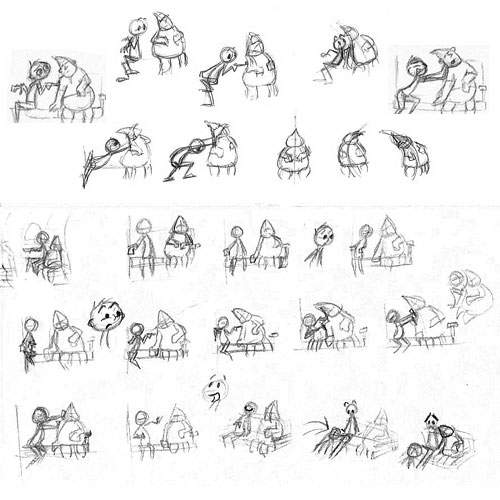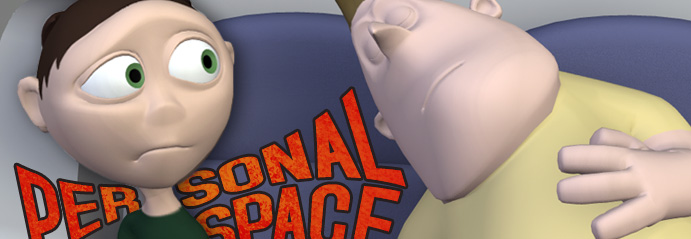 |
Animation Mentor:
How did you come up with the concept for your short film?
Valerie Morrison:
When I was coming up with ideas for my short film, I was trying to think of different scenarios that almost everyone could relate to. It was my mom who suggested to do something about an annoying passenger on an airplane, and that sparked the story of my film. I felt the setting of the film would work well because it would naturally be a silent film, and I could see this great opportunity to really get inside the character’s head and show what he was thinking. I actually had two short film ideas that I really liked, one being Personal Space and the other about two office workers. In the end I chose Personal Space because it was shorter and I could finish it during my sixth class.
Animation Mentor:
What important lessons did you learn from making your short film?
Valerie Morrison:
Everything always takes longer than you think. That is mainly because of the unexpected. Maya will throw bugs at you. Your mentor will change their mind about how you should animate a part of your film. Character actions don’t translate as well on the screen as they did in your head so you’ll have to rethink ideas. I thought I would have plenty of time to get my 45 second film done in three months, but there was a lot of crunch time, especially at the end. It also taught me to spend a lot of time on my blocking. Make sure the poses in the blocking phase are strong, and put a lot of poses and information in the blocking so your mentor knows what you have in mind.
Animation Mentor:
How long did it take to complete your film?
Valerie Morrison:
I did the planning and pre-production work in class 5, which took three months. Then I created the animation in class 6, which was another three months. Post production including lighting and rendering I did in about a week. Looking back I wish I’d started on the blocking process in class 5 so I would have had more time for the animation. Especially since I was working a full time job at the same time and just had some nights and weekends to work on my film.
Animation Mentor:
How much planning was put into your short film? Did planning help make the process easier?
Valerie Morrison:
Pitching the story really helped me get the idea solid in my head. I naturally would act out the characters during the pitch, and that was good reference as well as some other footage that I shot. I also found the small thumbnails I did were incredibly helpful. They weren’t much more than stick figures at times, but the simplicity and small size of the image would help me focus on the arcs and positions of the characters relative to each other.
Animation Mentor:
Do you mind sharing some of the pre-production work with us with a little explanation of what we’re looking at.
Valerie Morrison:
Here's the pitch of my film. I really wanted to have a good story for the base of my film, and I felt that if I could tell a good story with just words, then it would transfer well into animation. I tried to act out the characters a little as I told the story to really sell the ideas.
These are some quick thumbnails I did. I wasn't trying for detail, only to get the staging and arcs of the characters easily readable. I found them quite helpful in making my storyboards and when I was posing my characters in Maya.

This is my animatic of my storyboards. I'm not very happy with the quality of my drawings, as I had little time to spend working on it, but I think it really helped me get the timing down and define the poses I wanted to hit.
This is the layout of my film. Since my characters are sitting the entire time, keeping the models in a T-pose wasn't showing enough information, so I took a copied pairs approach with simple poses and computer generated in-betweens to get the timing down.
This is my film in blocking plus phase. It's come a long way from the layout stage, but there's still a lot of polishing to do before it's done, especially with arcs and keep-alive.
Animation Mentor:
What obstacles, if any, did you experience during the creation of your short film? How did you work your way around them?
Valerie Morrison:
It never fails that for every project I do, Maya will throw me a new bug to mess up my animation. In the fourth shot of my film (the long one where Bishop is pushing Otto), Bishop’s spine stretch/squash control would randomly quit working, and the only way I could fix it was by copying the animation from that file and pasting it on an earlier file where that control was still working, which I had to do several times. There were also struggles with getting the characters close enough to feel crowded, yet still have enough room to get the poses and animation I wanted, especially with Bishop’s long arms and giant hands. In the end I found a pretty good balance for that, and used the stretch feature on Bishop’s arms a few times.
Animation Mentor:
Tell how your Animation Mentor experience helped you in creating your short film.
Valerie Morrison:
Animation Mentor has been an incredible experience from the very beginning. My short film would not look anything like it does now if I had not learned so much from my amazing mentors. The detailed feedback from their critiques has helped me greatly improve as an animator, and the student community has been a wonderful asset. And I am especially grateful for the awesome character models that Animation Mentor has provided for us. I’m really glad Animation Mentor has the short film classes as part of the curriculum.
|
 |



